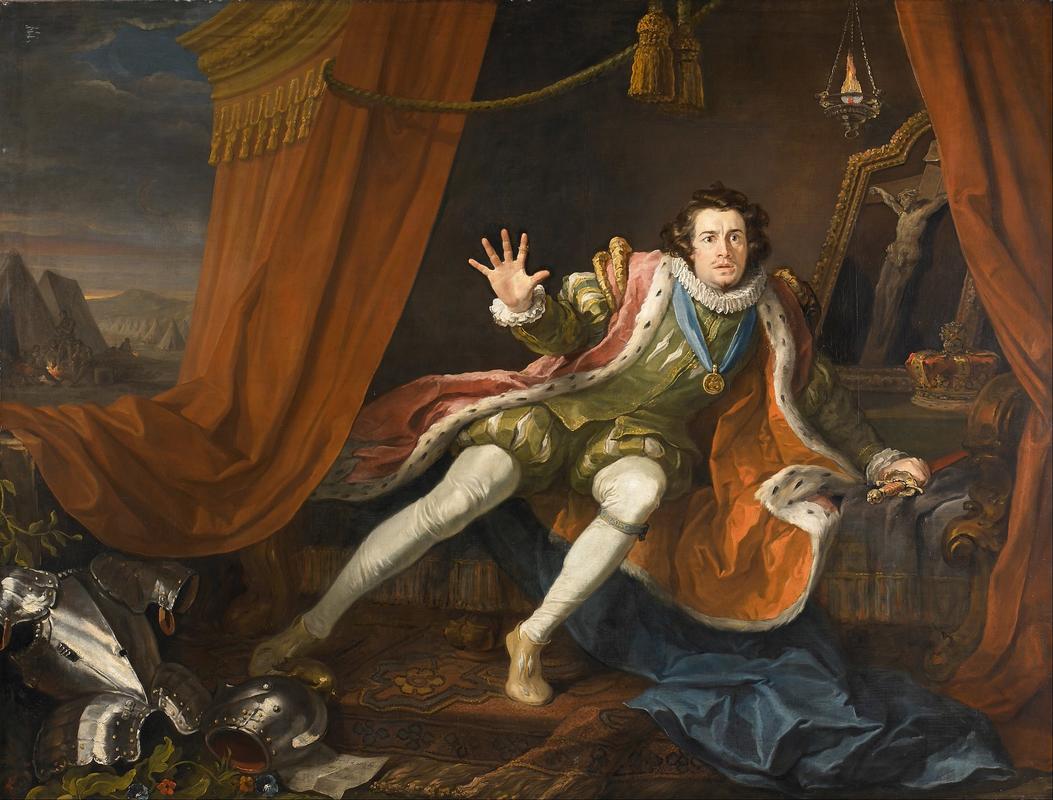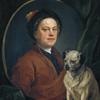More about David Garrick as Richard III

Sr. Contributor
Hogarth captures David Garrick in the role that transformed him into the world’s first celebrity.
It’s easy to think of acting as simply pretending to be a different person. If the audience is convinced, it’s good acting. But the realism we’ve become accustomed to seeing from modern actors wasn’t always so commonplace. Two hundred years ago the standard for acting was rehearsing a series of stiff gestures and facial expressions for all dialogue, like an exaggerated pantomime or as one actor of the time called it “paint-by-numbers.”
Then David Garrick premiered as Richard III at Drury Lane theater. He portrayed the well-known murderous king as deeply human and even vulnerable when haunted by the ghosts of those he murdered as captured here in Hogarth’s painting. To get an idea of how the audience may have felt, imagine an ensemble of stiff actors belting out their lines in exaggerations that feel far too rehearsed, then Christoph Waltz walks out on stage. Or alternatively, binging a series of awkwardly acted pantomimes then switching to a good episode of Games of Thrones.
While his contemporaries acted with planned out motions and shouts, he delved into the psychology of his character and explored his motivations. This technique caught on quickly, and Stanislavski’s Method developed from similar concepts years later and is now utilized by far too many modern actors to list here.
Garrick is much like Orson Welles both in his large amount of self-confidence and ingenuity in selling himself and manipulating the media turning himself into the world’s first celebrity. Plenty of people in history enjoyed fame prior to him, but he was the first to have paparazzi-esque media attention because the modern press was emerging around the time of his acting debut.
This portrait of Garrick wasn’t commissioned by anyone in particular. Hogarth painted it confident it would sell based on Garrick’s celebrity. It ended up selling for two hundred pounds, the highest price paid for a single portrait of an English artist at the time. The sales didn’t end there though, Garrick utilized the sale of both the original portrait and prints to advertise in the papers while also cross-promoting it with an upcoming performance of Richard III. Nowadays, paparazzi seek to capture images of celebrities off guard, but Garrick managed to have some control over his own portrayal. Partly because he was friends with a successful artist, but mostly because cameras weren’t a thing yet.
Garrick and Hogarth became rather close life-long buds. Garrick commissioned a good deal of portraits from the artist and held him in high regard even contributing a rather poignant verse to his gravestone when his dear friend passed that reads:
If Genius fire thee, reader, stay,
If Nature touch thee, drop a tear
If neither moves thee, turn away,
For Hogarth's honoured dust lies here.
Sources
- Jones, Jonathan. "David Garrick as Richard III, William Hogarth (1745)." The Guardian. May 06, 2000. Accessed July 17, 2019. https://www.theguardian.com/culture/2000/may/06/art.
- Knight, Joseph. David Garrick. Nabu Press, 2010.
- Poser, Norman S. The Birth of Modern Theatre: Rivalry, Riots, and Romance in the Age of Garrick. London: Routledge, Taylor & Francis Group, 2019.
- Ritchie, Leslie. David Garrick and the Mediation of Celebrity. Cambridge, United Kingdom: Cambridge University Press, 2019.
Featured Content
Here is what Wikipedia says about David Garrick as Richard III
David Garrick as Richard III is a painting dating from 1745 by the English artist William Hogarth.
The painting is usually said to show the actor and stage manager David Garrick in the role of Richard III in Shakespeare’s play. In fact it records his performance in the radically adapted version of Colley Cibber, whose Richard III held the stage from 1700 until 1896. It depicts a dramatic moment in the play on the eve of the Battle of Bosworth (1485). The king, who had been asleep in his tent on the battlefield, has just woken from a dream in which he has seen the ghosts of the opponents he had previously murdered. Hogarth was a friend of Garrick, who had gained a degree of fame through his portrayal of Richard III at the Drury Lane Theatre in London. The painting shows the actor with fear and concern, one arm raised and with a shocked expression on his face. Garrick both debuted upon the London stage, and retired from acting, in the role of Richard III.
Hogarth, best remembered for his satirical prints on social themes, was also a skilled painter and portraitist. This painting, much more than just a portrait, shows the subject at a key time in history, and also in theatrical pose. It falls between the commonly accepted genres of portraiture and historical painting. The pose used by Hogarth was similar to other that used for other portraits of actors, especially those by Zoffany. Having compared Hogarth's painting with those of Garrick by Reynolds, Gill Parry concludes that Hogarth had helped to establish a new subgenre within portraiture, that of the theatrical portrait. The pose adopted by the actor was described by Hogarth as "the serpentine line"; he saw it as "being composed of two curves contrasted". In his 1753 treatise The Analysis of Beauty he suggests that this is a particularly beautiful shape which "gives play to the imagination and delights the eye".
The painting is in oil on canvas and measures 190.5 centimetres (75.0 in) by 250.8 centimetres (98.7 in). It is owned by the Walker Art Gallery in Liverpool, Merseyside, England, and was purchased by the gallery in 1956 with help from the National Art Collections Fund.
Check out the full Wikipedia article about David Garrick as Richard III












